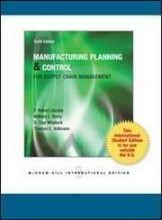Summary: Production Management
- This + 400k other summaries
- A unique study and practice tool
- Never study anything twice again
- Get the grades you hope for
- 100% sure, 100% understanding
Read the summary and the most important questions on Production Management
-
S&OP and Demand Planning
This is a preview. There are 9 more flashcards available for chapter 12/02/2019
Show more cards here -
Why is information sharing so important in S&OP and Demand planning?
Without information sharing your inventory will increase because of uncertain demand. -
Explain the effect of collaborative Planning, Forecasting, and Replenishment (CPFR)
CPFR = formal interfirm collaboration process in which you jointly manage the demand planning process. Information is efficiently shared (e.g. sales, inventory, promotion). The idea is to manage and plan demand together. First, they make a business plan: what kind of goals? And they make a collaborative planning. Second, they forecast collaborative. Lastly, they replenish in a collaborative way. -
Explain the process flow of CPFR
First, after a front end agreement with customer and supplier, they make together a business plan (1 a 2 years in future): each party creates sales forecast from the retailer to consumer side. They compare differences in sales forecasting and identify expectations for sales forecast. After that they resolve/ collaborate on exceptions.
Second, they create both order forecast and compare them and identify exceptions. After that, they resolve/ collaborate on exceptions.
After these important processes they are able to generate en deliver orders. -
The second process for single demand planning is Sales and Operations planning. Explain this process.
S&OP is a decision - making process for balancing demand and supply.
The process consists of a series of meetings, finishing with a high-level meeting where key intermediate-term decisions are made.
This process must occur at an aggregate level as well as a the detailed individual product level. -
Why is forecasting so important for every business organization?
Forecasting is important to make projections about how much the company will sell.
Accounting and finance: Basis for budgetary planning and cost control
Marketing: New product plans, sales personnel compensation, promotion, etc.
Production/ SCM: Supplier selection, process design, capacity planning, purchasing quantity, production planning, scheduling, inventory, etc. -
What's the difference between qualitative and quantitative type of forecasts?
Qualitiative:
- Subjective or judgemental: based on judgements
- Techniques based on opinions and estimates
Quantitative:- Causal relationships
- Time Series Analysis (e.g. regression analysis, simple moving average) -
What types of qualitative forecast methods are there?
1. Market research: uses surveys and interviews to ask end consumers about their opinion: how much interested? This type is used mostly for new product ideas, likes/dislikes, product competition.
2. Historical analogy: Trying to forecast for a new product using an existing or generic product as a model.
3. Grass roots: builds the forecast successively from the ground up. Based on the assumption that the person closer to the customers can better predict future demand.
4. Executive judgement and panel consensus: Forecasts are developed through open meetings and free exchange of ideas. -
What types of quantitative types of forecasting are there?
- Causal relationships: what are underlying causes for demand?
• Assumes that demand is related to some underlying factor(s) in the environment
• Simple or Multiple Regression Analysis
Time Series Analysis:
• Based on the idea that data relating to past demand can be used to predict future demand
• Simple moving average
• Weighted moving average
• Exponential smoothing
• Regression analysis -
Explain decomposition of a Time Series
Time series: Chrnologically ordered data that may contain one or more components of demand.
Decomposition: identifying and separating the time series data into its components -
What's the difference between additive and multiplicative seasonal variation?
Seasonal variation:
Additive: The seasonal amount is constant
Multiplicative: The seasonal variation is a percentage of demand.
Multiplicative seasonal models are basically better.
To calculate seasonal demand --> see slides
- Higher grades + faster learning
- Never study anything twice
- 100% sure, 100% understanding






























